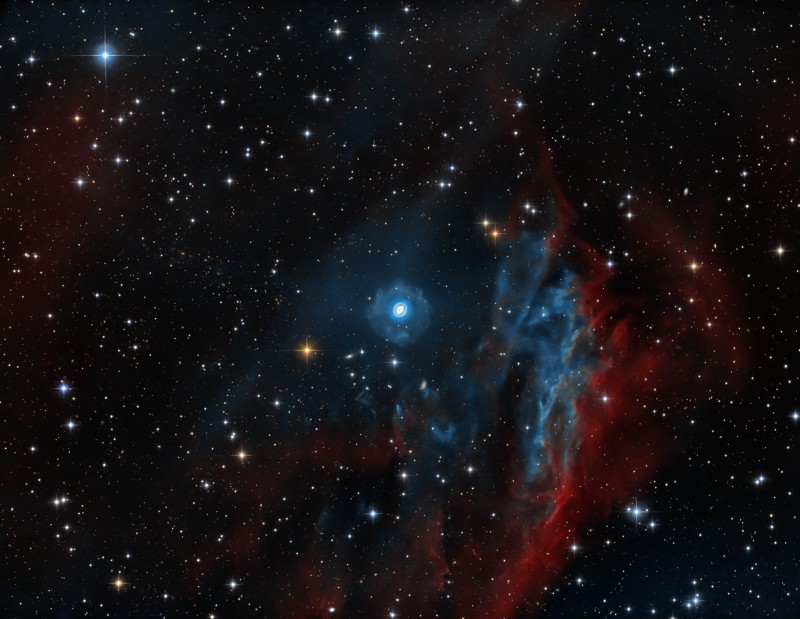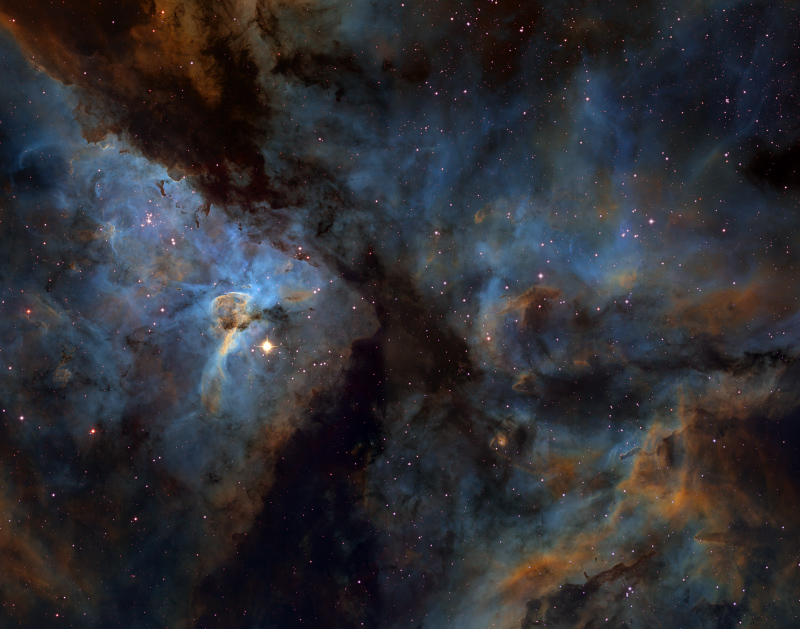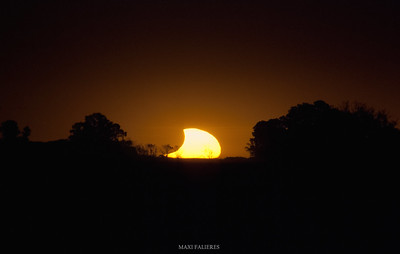Submissions: 2022 April
Re: Submissions: 2022 April
NGC 3572 in Hubble Palette
Copyright: Bogdan Borz
This is NGC 3572 and the nebula surrounding it, a narrowband project using the T2 Newtonian from Chilescope.
Telescope : ASA Newtonian 500mm f3.8
Camera : FLI Proline 16830
Filters : Astrodon 3nm Ha, SII, OIII
Exposure: 11 x 600s x 3 ; 5h30
Dates : March 26, 28, April 04 2022
Location: Chilescope, Rio Hurtado, Coquimbo, Chili
Processing: Pixinsight, Photoshop
Full version: https://www.astrobin.com/full/na2hu6/0/?mod=&real=
Copyright: Bogdan Borz
This is NGC 3572 and the nebula surrounding it, a narrowband project using the T2 Newtonian from Chilescope.
Telescope : ASA Newtonian 500mm f3.8
Camera : FLI Proline 16830
Filters : Astrodon 3nm Ha, SII, OIII
Exposure: 11 x 600s x 3 ; 5h30
Dates : March 26, 28, April 04 2022
Location: Chilescope, Rio Hurtado, Coquimbo, Chili
Processing: Pixinsight, Photoshop
Full version: https://www.astrobin.com/full/na2hu6/0/?mod=&real=
Re: Submissions: 2022 April
NGC3242 Ghost of Jupiter
Copyright: Wolfgang Promper http://www.astro-pics.com/3242rcm.htm
http://www.astro-pics.com/3242rcb.jpg
Copyright: Wolfgang Promper http://www.astro-pics.com/3242rcm.htm
http://www.astro-pics.com/3242rcb.jpg
Last edited by bystander on Sat Apr 23, 2022 3:38 pm, edited 1 time in total.
Reason: Please, no hot links to images > 500 kb. Substituted smaller image.
Reason: Please, no hot links to images > 500 kb. Substituted smaller image.
Re: Submissions: 2022 April
ETA CARINA
Copyright:Wolfgang Promper http://www.astro-pics.com/3372mrcm.htm
Copyright:Wolfgang Promper http://www.astro-pics.com/3372mrcm.htm
-
maxifalieres
- Ensign
- Posts: 19
- Joined: Fri Dec 18, 2020 6:39 pm
Re: Submissions: 2022 April
The Moon with clouds and The Sun - 24/04/2022
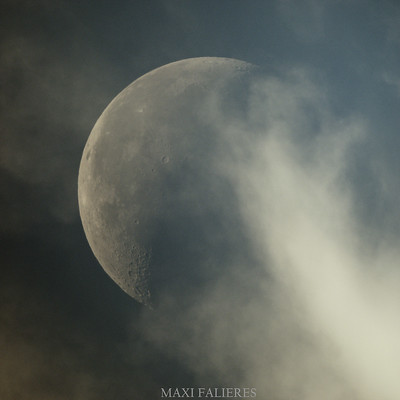
Luna 24-04-2022
by Maximiliano Falieres, en Flickr
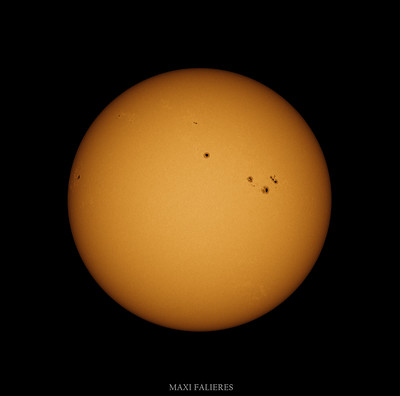
Sol 24-04-2022
by Maximiliano Falieres, en Flickr

Luna 24-04-2022
by Maximiliano Falieres, en Flickr

Sol 24-04-2022
by Maximiliano Falieres, en Flickr
Re: Submissions: 2022 April
Zero Shadow Day, the day on which the sun is directly overhead at local noon.
For Chennai, India at 13°N it was on 24th Apr 12:07PM. The sun reaching 89.6°altitude.
Interesting fact : This event happens only for locations between 23.5°N to 23.5°S latitudes, which leaves out the entire continental unites states and Europe.
The image was captured by my DIY all sky camera setup. Powered with a Rasperry Pi HQ camera / fisheye lens combo. North is left and West is top in the image.
For Chennai, India at 13°N it was on 24th Apr 12:07PM. The sun reaching 89.6°altitude.
Interesting fact : This event happens only for locations between 23.5°N to 23.5°S latitudes, which leaves out the entire continental unites states and Europe.
The image was captured by my DIY all sky camera setup. Powered with a Rasperry Pi HQ camera / fisheye lens combo. North is left and West is top in the image.
Re: Submissions: 2022 April
-
Yovin Yahathugoda
- Ensign
- Posts: 21
- Joined: Tue Feb 09, 2021 2:56 pm
Re: Submissions: 2022 April
IC 434 - Horsehead Nebula
https://www.astrobin.com/users/YovinRY/
Copyright: Yovin Yahathugoda
Image credit: Yovin Yahathugoda/Telescope Live
This image was taken using Telescope Live SPA-2 telescope at IC Astronomy, Spain
Full quality version here: https://cdn.astrobin.com/images/86236/2 ... fa4423.png
Telescope - Officina Stellare ProRC 700
Camera - FLI PL16803
Filters - Astrodon E-Series LRGB
Software - Photoshop 2020 & PixInsight
Location - IC Astronomy, Spain
Dates: December 2021 - January 2022
Luminance - 15x600s
Red - 10x600s
Green - 11x600s
Blue - 10x600s
Total Exposure time - 7 hours 40 mins
Full acquisition details at https://www.astrobin.com/0dbde0/0/
https://www.astrobin.com/users/YovinRY/
Copyright: Yovin Yahathugoda
Image credit: Yovin Yahathugoda/Telescope Live
This image was taken using Telescope Live SPA-2 telescope at IC Astronomy, Spain
Full quality version here: https://cdn.astrobin.com/images/86236/2 ... fa4423.png
Telescope - Officina Stellare ProRC 700
Camera - FLI PL16803
Filters - Astrodon E-Series LRGB
Software - Photoshop 2020 & PixInsight
Location - IC Astronomy, Spain
Dates: December 2021 - January 2022
Luminance - 15x600s
Red - 10x600s
Green - 11x600s
Blue - 10x600s
Total Exposure time - 7 hours 40 mins
Full acquisition details at https://www.astrobin.com/0dbde0/0/
Re: Submissions: 2022 April
M-51/The Whirlpool Galaxy and
For the past two months, I have been working on reimaging The Whirlpool Galaxy with the purpose of capturing a Quasar [VV2006] J133004.8+472301 that is approximately 11 Billion Light Years away. It's tiny...REALLY tiny but I got. Thank you for your consideration.
Astro Nerd Data:
Target: M-51 The Whirlpool Galaxy
Imaging Telescope: Explore Scientific ED127 CF
Imaging Camera: ZWO ASI2600MM-Pro
Session Control: ZWO ASIAir+
Guide Scope: Explore Scientific ED127 CF
Guide Camera: ZWO 290mm-Mini
Mount: SkyWatcher EQ8R-Pro
Polar Alignment: ASIAir+
Bortle Class: 6
Frames:
170 x 180s (L) - 8.5 Hours
100 x 180s (R) - 5 Hours
50 x 180s (G) - 2.5 Hours
50 x 180s (B) - 2.5 Hours
Filter: Chroma LRBG
Integration: PixInsight
Topaz DeNoise AI
Adobe PhotoShop Express
21 Mar 2022 / 01, 21, 23, 24, 25 Apr 2022
Full Resolution: https://astrob.in/xadnjm/B/
For the past two months, I have been working on reimaging The Whirlpool Galaxy with the purpose of capturing a Quasar [VV2006] J133004.8+472301 that is approximately 11 Billion Light Years away. It's tiny...REALLY tiny but I got. Thank you for your consideration.
Astro Nerd Data:
Target: M-51 The Whirlpool Galaxy
Imaging Telescope: Explore Scientific ED127 CF
Imaging Camera: ZWO ASI2600MM-Pro
Session Control: ZWO ASIAir+
Guide Scope: Explore Scientific ED127 CF
Guide Camera: ZWO 290mm-Mini
Mount: SkyWatcher EQ8R-Pro
Polar Alignment: ASIAir+
Bortle Class: 6
Frames:
170 x 180s (L) - 8.5 Hours
100 x 180s (R) - 5 Hours
50 x 180s (G) - 2.5 Hours
50 x 180s (B) - 2.5 Hours
Filter: Chroma LRBG
Integration: PixInsight
Topaz DeNoise AI
Adobe PhotoShop Express
21 Mar 2022 / 01, 21, 23, 24, 25 Apr 2022
Full Resolution: https://astrob.in/xadnjm/B/
Re: Submissions: 2022 April
M63 Galaxy
12 "Truss RC telescope reduced to 1790
Moravian off-axis guider and Moravian G0300 guide camera
Celestron 80/600 guide tube with Asi Zwo 224
Moravian G2 8300 camera with internal wheel
Ioptron Cem120 mount
Moonlite focuser and 3.5 "electronic rotator
Electronic temperature control and anti-condensation bands
Cls ccd, R, G, B, Ha 6nm filters, all Astronomik
Shooting data:
51x300s Cls Ccd
15x600s Ha 6nm
21x240s R
21x240s G
21x240s B
Processing: Pixinsight, Photoshop, star spikes, astronomy tools
Full resolution: https://flic.kr/p/2ngNjvM
12 "Truss RC telescope reduced to 1790
Moravian off-axis guider and Moravian G0300 guide camera
Celestron 80/600 guide tube with Asi Zwo 224
Moravian G2 8300 camera with internal wheel
Ioptron Cem120 mount
Moonlite focuser and 3.5 "electronic rotator
Electronic temperature control and anti-condensation bands
Cls ccd, R, G, B, Ha 6nm filters, all Astronomik
Shooting data:
51x300s Cls Ccd
15x600s Ha 6nm
21x240s R
21x240s G
21x240s B
Processing: Pixinsight, Photoshop, star spikes, astronomy tools
Full resolution: https://flic.kr/p/2ngNjvM
-
Mathieu80
Re: Submissions: 2022 April
 The Spider and the Fly by Mathieu Guinot, sur Flickr
The Spider and the Fly by Mathieu Guinot, sur FlickrHere is the Spider and the Fly.
The Spider IC417 and the Fly NGC1931 are two emission nebulae located respectively about 10,000 and 7,000 light-years away in the constellation Auriga, near the famous IC405 & IC410 nebulae.
Newton 250mm f/3.8
Mount Ioptron CEM70
Imaging camera ASI2600mm + SHO filters
Guiding camera ASI290mm mini + OAG M68
19h05 exposures from Amiens (France, Bortle 7) in March 2022.
H : 73x300s
S : 79x300s
O : 77x300s
Processing : Pixinsight & Photoshop
-
PaleBrownShed
- Asternaut
- Posts: 3
- Joined: Thu Oct 14, 2021 9:39 pm
Re: Submissions: 2022 April
This unique version of a classic target was imaged from my Bortle 5 backyard in Ayr, Ontario, Canada
Main Equipment:
Sky-Watcher EQ6-R Pro
Sky-Watcher 100ED
ASI2600MM Pro
ASI120MM (Guide camera)
ASIAIR-Pro
ZWO EAF
Astronomik SHO filters
720 second subs
Software: PixInsight and Photoshop
David Jenkins
Main Equipment:
Sky-Watcher EQ6-R Pro
Sky-Watcher 100ED
ASI2600MM Pro
ASI120MM (Guide camera)
ASIAIR-Pro
ZWO EAF
Astronomik SHO filters
720 second subs
Software: PixInsight and Photoshop
David Jenkins
Re: Submissions: 2022 April
Conjunction Moon, Venus and Jupiter
27.April. 2022 - Dubai U.A.E
https://www.flickr.com/photos/190440294 ... ed-public/
https://www.flickr.com/photos/190440294 ... ed-public/
Copyright: Tameem Al Tameemi
27.April. 2022 - Dubai U.A.E
https://www.flickr.com/photos/190440294 ... ed-public/
https://www.flickr.com/photos/190440294 ... ed-public/
Copyright: Tameem Al Tameemi
Odd Clouds
Looked at the conjunction this morning and saw the oddest clouds. Shot with a Pixel 3 in Hartford, AL, USA
This appears to be the launch of NASA's Crew 4 Mission on SpaceX Falcon 9.
This appears to be the launch of NASA's Crew 4 Mission on SpaceX Falcon 9.
Last edited by MrRat on Wed Apr 27, 2022 8:12 pm, edited 1 time in total.
-
Bruno Saisi
Re: Submissions: 2022 April
Planetary conjunction and Falcon 9 contrail
I got up early this morning to take some pictures of the planetary conjunction and I was treated with two nice surprises:
1) In addition to Jupiter, Venus, Mars, Saturn and the Moon, Neptune is (barely) visible in some images!
But the real treat is that 2) The contrail from the Falcon 9 launch was still visible (2 hours after launch) and made these beautiful "clouds" in the direction of the planets.

Full resolution: https://photos.smugmug.com/photos/i-Krv ... rv295b.jpg
Version without the annotations:

Full resolution: https://photos.smugmug.com/photos/i-nGd ... GdBMLk.jpg
Images taken with a Canon 6d + 100mm lens from Starkville, Mississippi.
And a wider field of view, taken with a 35mm lens:

Full resolution: https://photos.smugmug.com/photos/i-Rgp ... gpPf6Q.jpg
Same, but without the annotations:

Full resolution: https://photos.smugmug.com/photos/i-gcm ... cmkSc4.jpg
All images (c) Jean-Francois Gout
(Message edited to update links to new version of images with brightness increased a notch)
1) In addition to Jupiter, Venus, Mars, Saturn and the Moon, Neptune is (barely) visible in some images!
But the real treat is that 2) The contrail from the Falcon 9 launch was still visible (2 hours after launch) and made these beautiful "clouds" in the direction of the planets.

Full resolution: https://photos.smugmug.com/photos/i-Krv ... rv295b.jpg
Version without the annotations:

Full resolution: https://photos.smugmug.com/photos/i-nGd ... GdBMLk.jpg
Images taken with a Canon 6d + 100mm lens from Starkville, Mississippi.
And a wider field of view, taken with a 35mm lens:

Full resolution: https://photos.smugmug.com/photos/i-Rgp ... gpPf6Q.jpg
Same, but without the annotations:

Full resolution: https://photos.smugmug.com/photos/i-gcm ... cmkSc4.jpg
All images (c) Jean-Francois Gout
(Message edited to update links to new version of images with brightness increased a notch)
Last edited by jfgout on Thu Apr 28, 2022 12:05 am, edited 1 time in total.
Re: Submissions: 2022 April
NGC 6946 - Spiral Arms Revealed in the Fireworks Galaxy!
Image URL: https://www.kentbiggs.com/images/galaxies/N6946-2.htm
Video URL: https://www.kentbiggs.com/images/galaxies/N6946-2v.htm
This image and video of the active "Fireworks Galaxy" shows that by simply removing the foreground stars,
the faint details of a galaxy can sometimes be much better revealed! Use links above for full HD versions.
> Hover over image below to see a small version of the effect: > This static image below shows stars removed: Integration time: 15 hours. Copyright Kent E. Biggs. Sept 2021
Clear skies,
www.kentbiggs.com
Houston, Texas
Image URL: https://www.kentbiggs.com/images/galaxies/N6946-2.htm
Video URL: https://www.kentbiggs.com/images/galaxies/N6946-2v.htm
This image and video of the active "Fireworks Galaxy" shows that by simply removing the foreground stars,
the faint details of a galaxy can sometimes be much better revealed! Use links above for full HD versions.
> Hover over image below to see a small version of the effect: > This static image below shows stars removed: Integration time: 15 hours. Copyright Kent E. Biggs. Sept 2021
Clear skies,
www.kentbiggs.com
Houston, Texas
Last edited by kentbiggs on Thu Apr 28, 2022 6:41 pm, edited 3 times in total.
Re: Submissions: 2022 April
Solar Protuberances
Full Res Image : https://astromyl.com/src/SolarProtuberancesFull.jpg
Please look at the full res image to avoid compression.
Video of 1000 frames ; Exposure : 15.429ms Gain : 150
350 bests frames on 1000
Skywatcher EQ-6 Pro
Celestron C11 280/2800mm at f/d=10
Daystar Quark + ERF
ZWO ASI 178mm
From Montlucon, France
Copyright: Arthur M
Clear skies !
Please look at the full res image to avoid compression.
Video of 1000 frames ; Exposure : 15.429ms Gain : 150
350 bests frames on 1000
Skywatcher EQ-6 Pro
Celestron C11 280/2800mm at f/d=10
Daystar Quark + ERF
ZWO ASI 178mm
From Montlucon, France
Copyright: Arthur M
Clear skies !
-
astrohokie
- Ensign
- Posts: 36
- Joined: Thu Oct 14, 2021 10:32 pm
Re: Submissions: 2022 April
Melotte 15 starless

https://flic.kr/p/2nhiw7f
Melotte 15

https://flic.kr/p/2nhiw5g
Copyright Mark Hoffman
From NASA:
"Cosmic clouds form fantastic shapes in the central regions of emission nebula IC 1805. The clouds are sculpted by stellar winds and radiation from massive hot stars in the nebula's newborn star cluster, Melotte 15. About 1.5 million years young, the cluster stars are scattered in this colorful skyscape, along with dark dust clouds in silhouette against glowing atomic gas. A composite of narrowband and broadband telescopic images, the view spans about 15 light-years and includes emission from ionized hydrogen, sulfur, and oxygen atoms mapped to green, red, and blue hues in the popular Hubble Palette. Wider field images reveal that IC 1805's simpler, overall outline suggests its popular name - The Heart Nebula. IC 1805 is located about 7,500 light years away toward the boastful constellation Cassiopeia."
Equipment:
Celestron EdgeHD 8
Celestron EdgeHD 8 0.7 focal reducer
Celestron OAG
Celestron Autofocuser
ASI 174MM Guide Camera
ASI 294MM Pro Imaging Camera
ASI 7 position EFW
1.25in Chroma 5nm Ha, 3nm O3, 3nm S2 filters
Total Integration Time = 24.8 hours
Ha Integration Time = 8.8 hours
O3 Integration Time = 8.5 hours
S2 Integration Time = 7.5 hours
Virginia, USA
Bortle 7
Focal Length 1422mm

https://flic.kr/p/2nhiw7f
Melotte 15

https://flic.kr/p/2nhiw5g
Copyright Mark Hoffman
From NASA:
"Cosmic clouds form fantastic shapes in the central regions of emission nebula IC 1805. The clouds are sculpted by stellar winds and radiation from massive hot stars in the nebula's newborn star cluster, Melotte 15. About 1.5 million years young, the cluster stars are scattered in this colorful skyscape, along with dark dust clouds in silhouette against glowing atomic gas. A composite of narrowband and broadband telescopic images, the view spans about 15 light-years and includes emission from ionized hydrogen, sulfur, and oxygen atoms mapped to green, red, and blue hues in the popular Hubble Palette. Wider field images reveal that IC 1805's simpler, overall outline suggests its popular name - The Heart Nebula. IC 1805 is located about 7,500 light years away toward the boastful constellation Cassiopeia."
Equipment:
Celestron EdgeHD 8
Celestron EdgeHD 8 0.7 focal reducer
Celestron OAG
Celestron Autofocuser
ASI 174MM Guide Camera
ASI 294MM Pro Imaging Camera
ASI 7 position EFW
1.25in Chroma 5nm Ha, 3nm O3, 3nm S2 filters
Total Integration Time = 24.8 hours
Ha Integration Time = 8.8 hours
O3 Integration Time = 8.5 hours
S2 Integration Time = 7.5 hours
Virginia, USA
Bortle 7
Focal Length 1422mm
-
TaraMostofi
- Ensign
- Posts: 12
- Joined: Mon May 11, 2020 6:29 am
Re: Submissions: 2022 April
PLANETARY PARADE!
I took a detour on my way to work this morning to grab a picture of the crescent moon rising above Alcatraz, with Jupiter, Venus, Mars, and finally, Saturn gracefully posing above the cables of the north tower of the Golden Gate Bridge. Taken from Battery Spencer in the Marin Headlands. IA spectacular sunrise followed.
I took a detour on my way to work this morning to grab a picture of the crescent moon rising above Alcatraz, with Jupiter, Venus, Mars, and finally, Saturn gracefully posing above the cables of the north tower of the Golden Gate Bridge. Taken from Battery Spencer in the Marin Headlands. IA spectacular sunrise followed.
Re: Submissions: 2022 April
NGC 4565 (also known as C 38 or the Ago Galaxy) is a spiral galaxy in the Coma Berenices constellation. It is easily identified 2.5 degrees southeast of the star γ Comae Berenices; it is perfectly cut, so it looks like a long spindle. Visible even with modest instruments, in 200mm aperture telescopes the view is wonderful: for the entire length of the galaxy a dark band is clearly evident, in a slightly asymmetrical position with respect to the nucleus, which makes it extraordinarily similar to our Galaxy, to which on the other hand it approaches both in real form and in size. It is about 52 million light-years away from the Milky Way. Distance from Earth: 38,490,000 light years
12 "Truss RC telescope reduced to 1790
Moravian off-axis guider and Moravian G0300 guide camera
Celestron 80/600 guide tube with Asi Zwo 224
Moravian G2 8300 camera with internal wheel
Ioptron Cem120 mount
Moonlite focuser and 3.5 "electronic rotator
Electronic temperature control and anti-condensation bands
Cls ccd, R, G, B, Ha 6nm filters, all Astronomik
Shooting data:
51x240s Cls Ccd
21x240s R
21x240s G
21x240s B
Processing: Pixinsight, Photoshop, star spikes, astronomy tools
12 "Truss RC telescope reduced to 1790
Moravian off-axis guider and Moravian G0300 guide camera
Celestron 80/600 guide tube with Asi Zwo 224
Moravian G2 8300 camera with internal wheel
Ioptron Cem120 mount
Moonlite focuser and 3.5 "electronic rotator
Electronic temperature control and anti-condensation bands
Cls ccd, R, G, B, Ha 6nm filters, all Astronomik
Shooting data:
51x240s Cls Ccd
21x240s R
21x240s G
21x240s B
Processing: Pixinsight, Photoshop, star spikes, astronomy tools
-
tommasostella
- Ensign
- Posts: 60
- Joined: Mon Nov 11, 2019 4:34 pm
Re: Submissions: 2022 April
The Witch's Head Nebula (NGC 1909)
https://www.facebook.com/tommaso.m.stella
Copyright: Tommaso Stella
Exposures taken in Taranto (Italy) on January 2022
Sky: Bortle 6
55x600s with Optolong L-Pro
07x900s with Optolong L-Enhance
Total exposure: 11 h
Telescope: Takahashi FS-60CB + Reducer 0,72x
Camera: QHY 168C
Filters: Optolong Astronomy Filter L-Pro + L-Enhance
Mount: Skywatcher AZ-EQ6 GT
Processing: DeepSkyStacker, PixInsight, Photoshop CC
https://www.facebook.com/tommaso.m.stella
Copyright: Tommaso Stella
Exposures taken in Taranto (Italy) on January 2022
Sky: Bortle 6
55x600s with Optolong L-Pro
07x900s with Optolong L-Enhance
Total exposure: 11 h
Telescope: Takahashi FS-60CB + Reducer 0,72x
Camera: QHY 168C
Filters: Optolong Astronomy Filter L-Pro + L-Enhance
Mount: Skywatcher AZ-EQ6 GT
Processing: DeepSkyStacker, PixInsight, Photoshop CC
-
salvatorecerruto
- Ensign
- Posts: 23
- Joined: Thu Aug 22, 2019 2:28 pm
Re: Submissions: 2022 April
 A year of the Sun by Salvatore Cerruto, su Flickr
A year of the Sun by Salvatore Cerruto, su FlickrI was curious to experience and touch how the path of the Sun changed during the year and here on April 4th of this year I take the camera left on the roof of my house after a very long wait. As soon as I extracted the film from the pinhole camera I observed something really unusual, almost bizarre. In human experience it is difficult to imagine an overall representation of the movement of the celestial bodies and stars over a very long time and with this experimentation it is immediately clear how during the span of a year the trajectory of the Sun changes so much both in amplitude and in declination. The lower trajectory in fact represents the winter solstice and the higher trajectories represent the approach to the summer solstice which would correspond to the highest arc which unfortunately is not shown in this photo. At the same time as the sun reaches an ever greater declination it rises more and more in the east and sets more and more in the west, thus increasing its amplitude as summer approaches and, decreasing it as winter approaches. As I mentioned, to make this photo I used a pinhole camera which, in my case, is nothing more than a simple can with a very small hole and a photographic film inside.
Technical data: f / 132, Ilford Pearl 5x7 "paper, 1 year exposure (04 April 2021/04 April 2022)
Shooting coordinates: 36.8740168,14.7546113 (Modica, Sicily, Italy)
Date: 2021-04-04/2022-04-04
Author: Salvatore Cerruto
-
maxifalieres
- Ensign
- Posts: 19
- Joined: Fri Dec 18, 2020 6:39 pm
Re: Submissions: 2022 April

https://photos.app.goo.gl/7vLwEqghT6Mq8QiR8
Mount: Explorer Scientific ExosII-GT
Scope: William's Optic's Zenithstar 81 with .8 field flattener
Guidescope: William's Optic's Slide-base UniGuide 50mm Scope
Main Cam: ZWO ASI1600MM monochrome
Guide Cam: ZWO ASI120MM monochrome
Filter Wheel: ZWO EFW 5
Exposure time: 12 hrs
Filters used: L,oIII,R,B
Gain: 40
Offset:10
Location: Mt. Dora, FL
